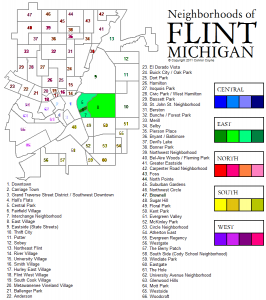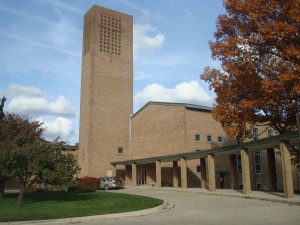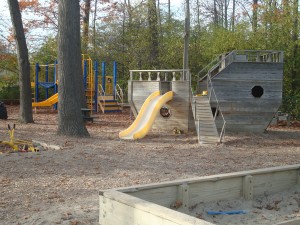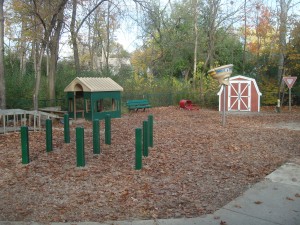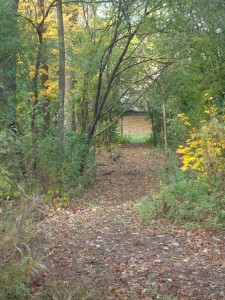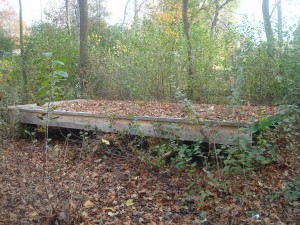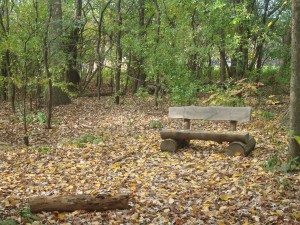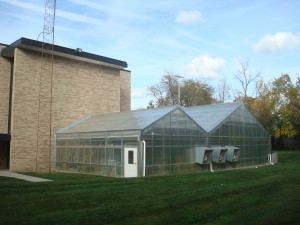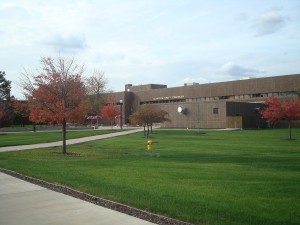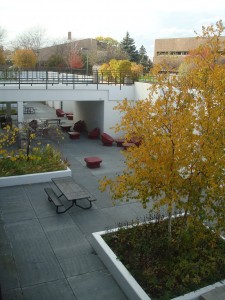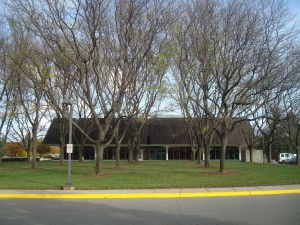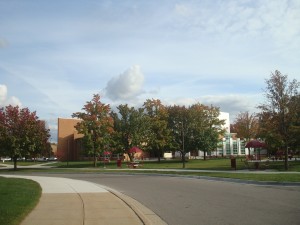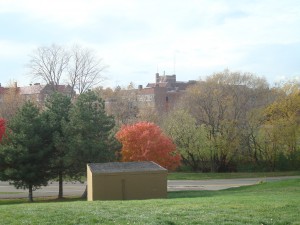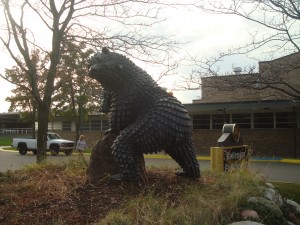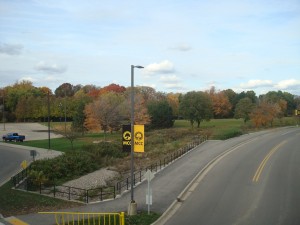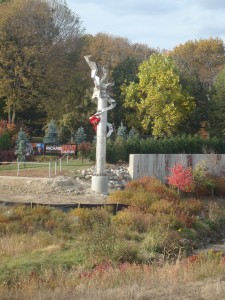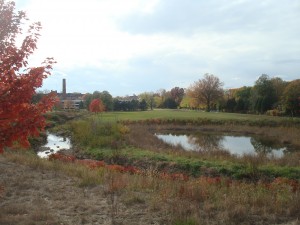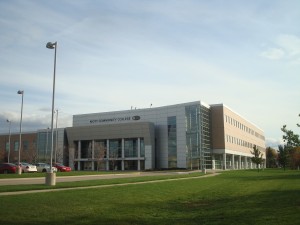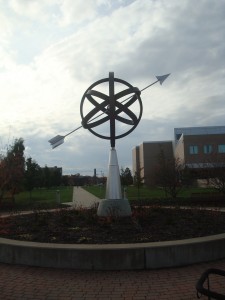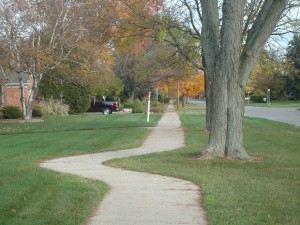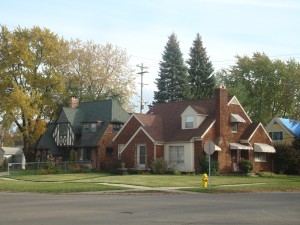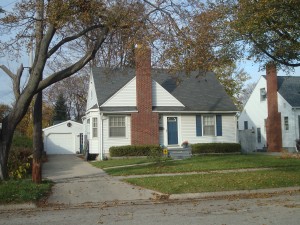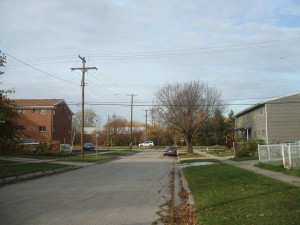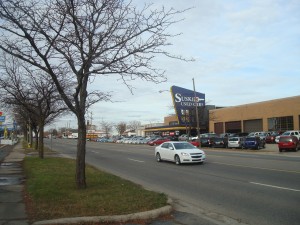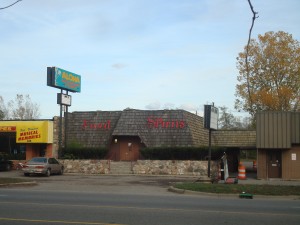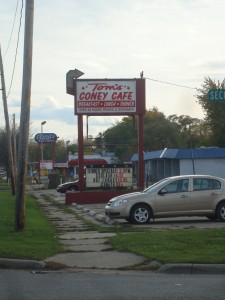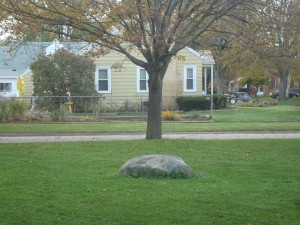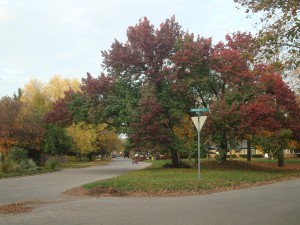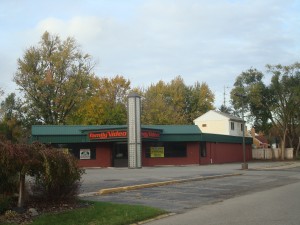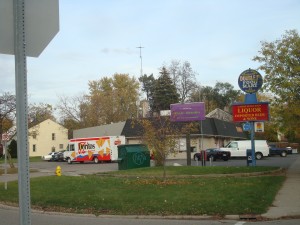Well it took me long enough! This is the second installment of my photoblog exploration of East Village, Flint, the neighborhood where I grew up and where I now live again after being away for 21 years. The first installment explored the area south of Court Street as well as Pierce Park. You can read that here. On the second trip, I went to Mott Community College and the area north of Court. This is the route I took:
And here is how the neighborhood fits into the larger layout of Flint:
Woodside Church, designed by Bloomfield Hills’ Eliel and Eero Saarinen, is one of the most distinctive landmarks in the neighborhood, with its striking steeple punctuating the night with bright amber sparks of light. The church is also known throughout the city as being a progressive, urban congregation with a history of involvement in the neighborhood. It is the only neighborhood church east of Gilkey Creek. I went to nursery school here.
Just behind the Woodside Church is the recently-built “Under the Oaks” playground. This is perfect for my daughter, as it is built specifically for children under five, and in addition to the swings and sandbox, and the massive conspicuous pirate ship, there’s also a small paved race track for bigwheels and some percussion instruments. And of course, the namesake oaks overhead.
Another view of Under the Oaks.
Beyond Under the Oaks is a small wooded area, the size of a city block, with paths cutting through. I don’t know whether this land belongs to Mott College, the city, or the church, but it seems to be full of potential to me. (EDIT: Liz tells me that it belongs to the church.) Gently overgrown today, the paths, benches, and firepits are nevertheless well-maintained and clear of underbrush. I’ve seen a few empty vodka bottles lying in some places, but I’ve also come across students back there, intent on their studies.
Just within the boundaries of this wooded area is an overgrown, disused platform… originally a stage? This seems like it would be a great place for small, impromptu meetings and performances… in the summer, perhaps a string quartet or a woolly one-act by Harold Pinter or Tennessee Williams.
Further back, you encounter several clearings with benches and firepits.
To the north, the wooded park abruptly opens up to the Gorman Science Center, with a greenhouse on the southern side.
The Curtis Mott Complex at Mott Community College. Mott, rated one of the ten best community colleges in the U.S. by the Aspen Institute is one of three college campuses within Flint city limits. The others are University of Michigan Flint, based Downtown, and Kettering University in Mott Park on the West Side. Other colleges are nearby outside the city.
I’ve always liked the architecture of Mott. It is both contemporary and stark, and in many cases (as in the Curtis Mott Complex) brutalist. This courtyard is tucked away behind the Prahl College Center at the very center of campus.
This is the Prahl center, itself. In my dreams, I imagine Mott staying open late, with a full-service and schedule restaurant and coffee shop on site. It hasn’t happened yet, but it isn’t that far-fetched. A recent lecture series featured Patti Smith, and enrollment may have topped out after years of growth.
Mott has also built a brand new library on Court Street. (EDIT: The library was built in the 1950s, and remodeled in the last year; I knew this but got ahead of myself. Thanks to Liz for the correction.) This too, is visually striking, and more sleek and expressionistic than the rest of the campus. I love walking around here. The only complaint is that the parking lots go on and on, like you’re at a huge mall. You have to cross ages of parking lots to get anywhere. But if a parking high-rise became possible in the future (or better, if the current garage straddling Applewood was more fully utilized), there’s great potential for lovely green space here.
The eastern extremity of the Mott Campus looks out over the (sadly, shuttered) campus of Whittier Middle School and Flint Central High School.
The Bruin Bare (aka “Babe”) is Mott’s mascot.
The northern edge of the Mott campus, lined with three parking garages, has a magnificent vista over the southern exposure of the Applewood Estate, historic home of the Mott Family.
This forty foot tall abstract sculpture was designed by Chicago sculptor Richard Hunt, and recently dedicated on the 110th birthday of Ruth Mott. While Charles Stewart Mott is well known across the world, his wife was active throughout her life in philanthropic support of Flint.
This is, of course, an aspect of the tension that permeates all facets of political and cultural life here. The auto industry so overwhelmed unrelated local institutions that there was little room or opportunity to diversify the economy before the giant withdrew… at the same time, GM’s presence transformed Flint into a thriving metropolis and infused it with a rich diversity which is still in effect to this day. From namesake streets filled with rotting abandoned homes to the sophisticated and well-endowed facilities Downtown and at the Cultural Center, the automotive founding fathers left a complicated and still-unfolding legacy. But of all these individuals, few would question that C.S. and Ruth Mott had the most enduring and positive impact on Flint. This is evident in the Mott Foundation and Flint Cultural Center (the latter which will be featured in the last installment of this series).
Looking west down Gilkey Creek toward Downtown.
The easternmost third of Mott’s campus used to be St. Joseph Hospital, a big brick complex with some gorgeous architectural touches. My grandfather was born there, and after the complex was shuttered in the early 1990s, some friends and I returned for some (very respectful) impromptu “tours.” I was sad when St. Joe’s was demolished, but I cannot argue that the space has been put to brilliant, glorious use. It is now the site of Mott Regional Technology Center, which looks stark and striking, both inside and out.
This armillary sphere is a landmark at the eastern most extreme of the Mott campus, on Second Street near Kensington, at the point where the neighborhood transitions residential again.
I always thought it kind of funny that the sidewalk is deferential to this tree, and only this tree.
While still considered to be one of the most desirable neighborhoods in the City of Flint, the part of East Village north of Court is not as affluent as the area to the south. Some elegant tudors sprawl along Second Street, Commonwealth Avenue, and Montclair Avenue, while the other streets are lined with tidy Cape Cods and ranches. I know these streets like the back of my hand.
Of course, I have to check in on the house where I grew up. Gold Avenue is a tiny street in two sections (I grew up on the western stretch) where almost all of the houses are Cape Cods. I haven’t spent any time here in years, but this was a great street to grow up on. You could ride your bike and play street hockey without a lot of traffic, it was safe enough to play hide-and-seek long after dark and go camping out in the front yard. There were eleven houses on my street, and almost every one had a senior living alone or a family with young children. It’s still a lovely part of the neighborhood to walk through, and when I was in town in 1999, I bumped into the then-owner of this house. She offered me a quick tour, and I was surprised at how much smaller the house seemed than it had when I was four-feet tall and weighed under 100 pounds.
The northern border of the neighborhood is Robert T. Longway, lined with low-rise apartment buildings that also extend along Meade Street to the east.
Dort Highway is… interesting. Someone should write a book about this most paradoxical of American roads. Locally, it is infamously known as the epicenter of Flint’s numerous red light districts… that’s far to the south of the East Village. It is also, in terms of traffic volume and access, possibly the most important road in the city after Saginaw Street (Pierson Road and Clio/Ballenger would also be contenders). What I find most astonishing about Dort, however, is that visually it looks dilapidated and bombed out, but you nevertheless find some of the most memorable businesses within the city tucked away amidst the ruin. I’m not talking about the strip clubs, either. Jellybean Bookstore is here. So is the “A-Frame” trophy factory. And locals in-the-know all know that the cheapest gas is always at the Speedway at the corner of Second and Dort (but expect to wait a bit, ideally while pumping your jam and eating some fries).
There’s more, too, as you’ll see:
The Aloha. This is where the momentous evening of my 21st birthday began (after a 20 hours hiatus since my dad took me out for a beer at Flushing Lanes). Three wonderful women, mothers to my best friends, took me out for a very memorable night on the town, and it all started here with a drink the size of my head, saccharine sweet, flaming, with four straws involved.
The Aloha is an illustration of things that are possible in Flint that are not possible many other places, and it is an idiosyncratic argument, but still true. When I lived in Chicago’s Hyde Park, one of my favorite bars was the obscene Tiki Lounge on 53rd Street, which was like the Aloha in practically every way. It was the only neighborhood bar open past two and starred the rudest waitresses in the world. This wasn’t an Ed Debevik’s act, these ladies were genuinely pissed off at everyone. But the Tiki couldn’t survive Chicago. It was bought up around 2000 and closed down to be turned into condos… eventually the whole building was simply demolished. And yet the Aloha thrives in Flint. It has outlasted most of General Motors, and who knows, it might even outlast me.
Here’s another wonderful and weird Dort Business… many neighborhoods in Flint still have their own coney islands and this is the only specimen in the East Village. What makes it weird is that I have never, in my whole life, seen one business change hands and names so many times, while still remaining essentially the same. I’ve long since lost track of the number of names this place has had — I still have to resist the urge to call it by its mid-90s name of “The Grapevine” (and it had already changed hands numerous times by then) — but I can never recall it having ever been anything but a coney island. In terms of their coneys — the real litmus test — I think it stands up admirably to those other East Side stalwarts of Angelo’s, the Starlite, and the Olympic. Their coffee works too, if you’re all out of filters.
While it is more consistently gridded than the area south of Court, there are lots of curving avenues running through the neighborhood here creating small triangular parks and unexpected-cul-de-sacs. It’s probably frustrating to get lost here, but I loved exploring as a kid. When I was very young, my brother and sister and I used to play around this rock. In the summertime, some friends would stretch a canopy across the road here and throw a big block party.
Of the curving streets I just mentioned, Commonwealth Ave. is a sort of “queen street” curving so dramatically that it ends up at a 90 degree angle to where it starts. Most of the triangular parks I mentioned branch off of Commonwealth in some way.
Now this is a gloomy sight. Aside from Dort (which isn’t really a neighborhoody street), this small cluster of businesses at Court and Franklin is the only business strip in the neighborhood, and it is now almost entirely empty. The anchor business for decades was Mitchell’s Grocery, which was bought up by Family Video in the late 90s. I never thought that a video store provided good support for adjacent businesses; it makes sense to stop for ice cream or a haircut after going shopping, but after making a 30-second DVD run? Not so much. I guess I never stopped to consider that Family Video was far better than no business at all. This outlet closed this August, just two weeks after I moved back to the neighborhood. Now the building is empty.
The most reliable stalwart at Court and Franklin is Double J Food Mart. They’ve been there for longer than anyone else, so good for them, but it isn’t a supermarket. I can’t get dishwasher soap there, or often whole milk for my daughter. I believe that there is a viable solution out there for this important intersection, and that its success is instrumental not only to the ongoing success and stability of the East Village, but for East Flint as a whole.
UPDATE: The first installment is posted here. The third installment has been posted here.
